Employee Motivation: Theories, Strategies, and Impact on Performance
VerifiedAdded on 2023/01/18
|8
|2447
|31
Essay
AI Summary
This essay delves into the concept of motivation in the workplace, defining it as a crucial element for enhancing employee engagement and achieving organizational goals. It emphasizes the significance of motivation, highlighting its impact on productivity, positive attitudes, and a supportive work environment. The essay explores various strategies to improve motivation, including fulfilling employee needs based on Maslow's hierarchy, maintaining equity, and providing recognition and rewards. It also discusses the differences between intrinsic and extrinsic motivation, emphasizing the importance of cognitive evaluation theory. Furthermore, the essay integrates relevant motivational theories such as Maslow's hierarchy of needs, Herzberg's two-factor theory, and goal-setting theory, providing a comprehensive analysis of how these theories can be applied to boost employee motivation. The essay concludes by underscoring the importance of a positive work culture and the application of motivational theories to drive employee performance.
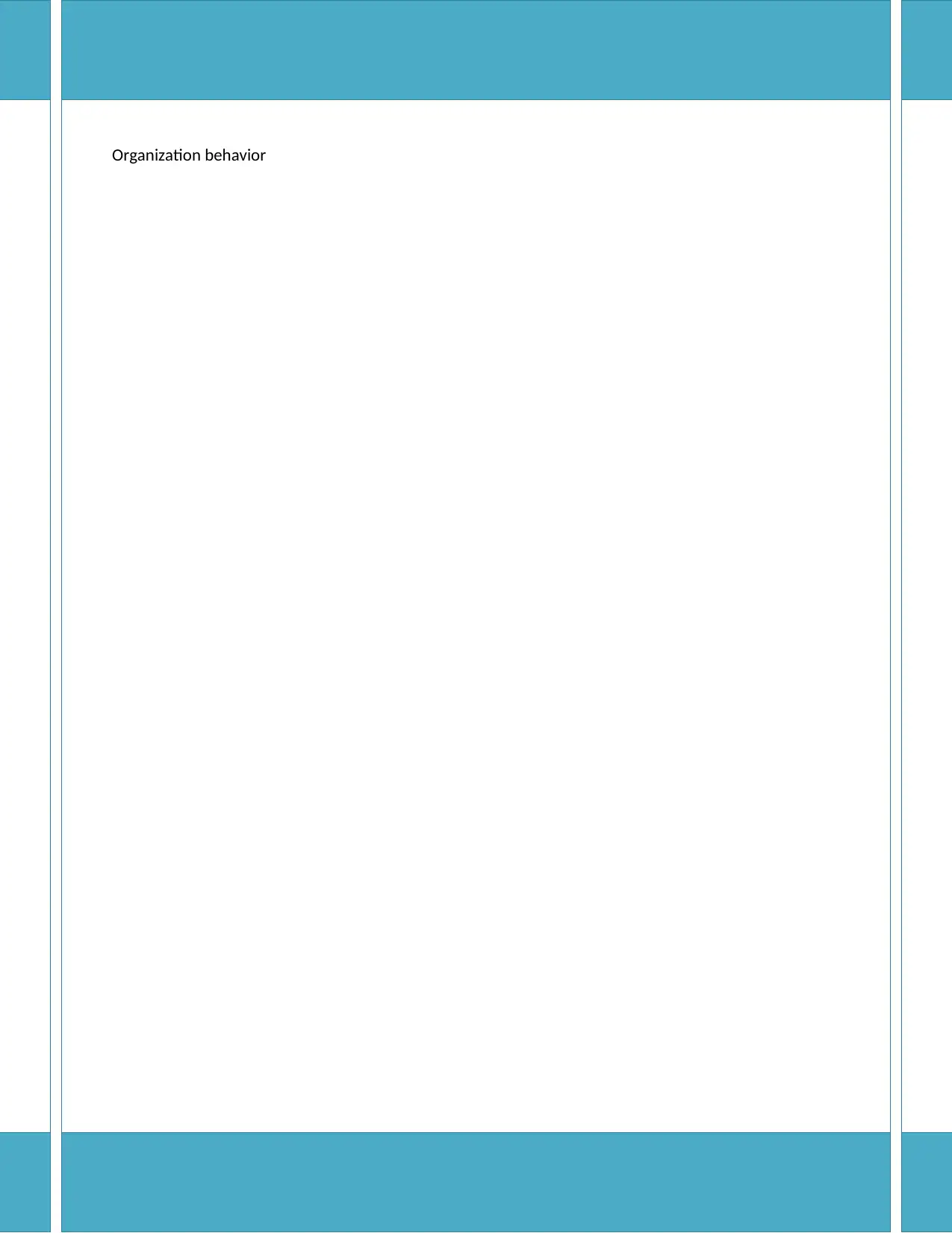
Organization behavior
Paraphrase This Document
Need a fresh take? Get an instant paraphrase of this document with our AI Paraphraser
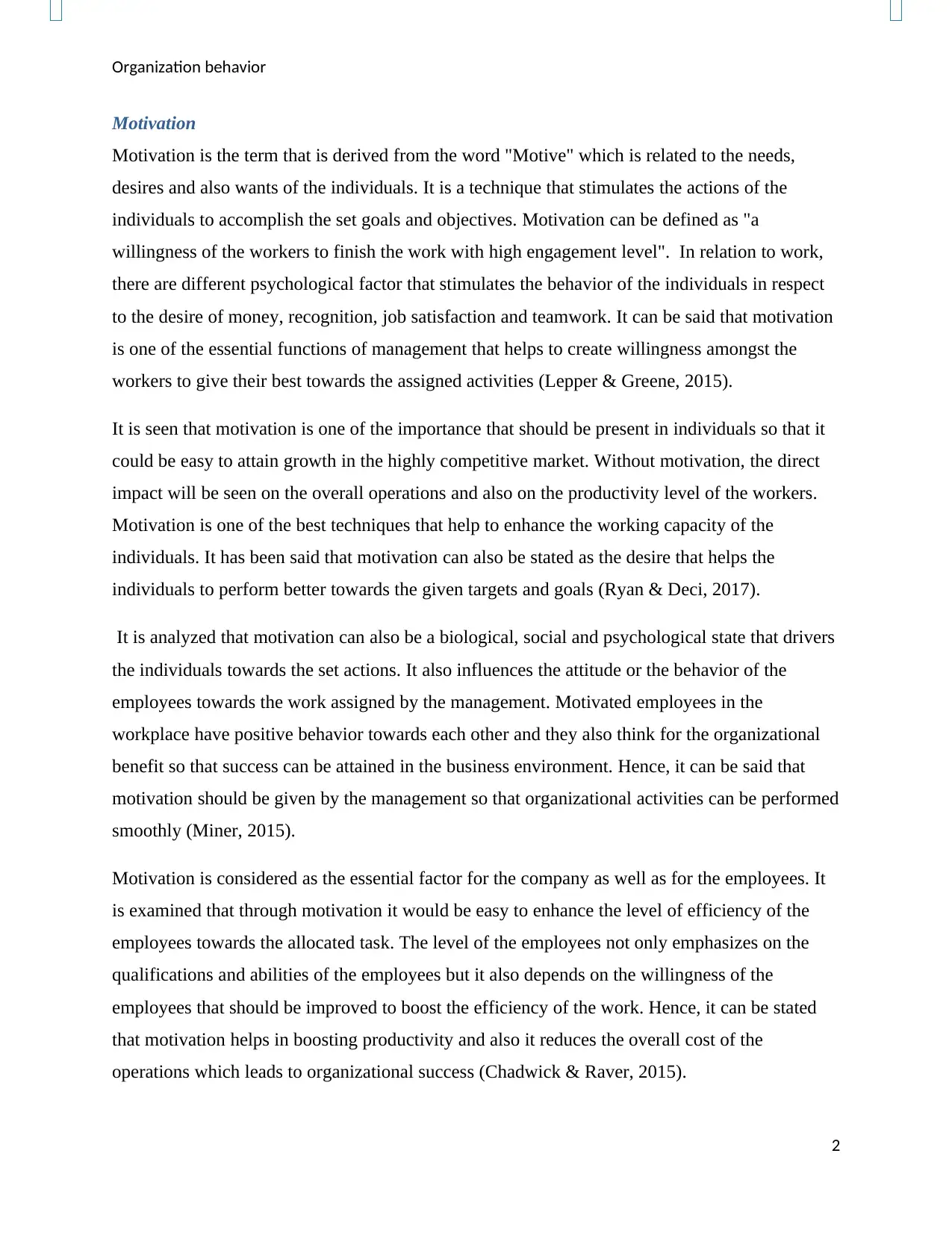
Organization behavior
Motivation
Motivation is the term that is derived from the word "Motive" which is related to the needs,
desires and also wants of the individuals. It is a technique that stimulates the actions of the
individuals to accomplish the set goals and objectives. Motivation can be defined as "a
willingness of the workers to finish the work with high engagement level". In relation to work,
there are different psychological factor that stimulates the behavior of the individuals in respect
to the desire of money, recognition, job satisfaction and teamwork. It can be said that motivation
is one of the essential functions of management that helps to create willingness amongst the
workers to give their best towards the assigned activities (Lepper & Greene, 2015).
It is seen that motivation is one of the importance that should be present in individuals so that it
could be easy to attain growth in the highly competitive market. Without motivation, the direct
impact will be seen on the overall operations and also on the productivity level of the workers.
Motivation is one of the best techniques that help to enhance the working capacity of the
individuals. It has been said that motivation can also be stated as the desire that helps the
individuals to perform better towards the given targets and goals (Ryan & Deci, 2017).
It is analyzed that motivation can also be a biological, social and psychological state that drivers
the individuals towards the set actions. It also influences the attitude or the behavior of the
employees towards the work assigned by the management. Motivated employees in the
workplace have positive behavior towards each other and they also think for the organizational
benefit so that success can be attained in the business environment. Hence, it can be said that
motivation should be given by the management so that organizational activities can be performed
smoothly (Miner, 2015).
Motivation is considered as the essential factor for the company as well as for the employees. It
is examined that through motivation it would be easy to enhance the level of efficiency of the
employees towards the allocated task. The level of the employees not only emphasizes on the
qualifications and abilities of the employees but it also depends on the willingness of the
employees that should be improved to boost the efficiency of the work. Hence, it can be stated
that motivation helps in boosting productivity and also it reduces the overall cost of the
operations which leads to organizational success (Chadwick & Raver, 2015).
2
Motivation
Motivation is the term that is derived from the word "Motive" which is related to the needs,
desires and also wants of the individuals. It is a technique that stimulates the actions of the
individuals to accomplish the set goals and objectives. Motivation can be defined as "a
willingness of the workers to finish the work with high engagement level". In relation to work,
there are different psychological factor that stimulates the behavior of the individuals in respect
to the desire of money, recognition, job satisfaction and teamwork. It can be said that motivation
is one of the essential functions of management that helps to create willingness amongst the
workers to give their best towards the assigned activities (Lepper & Greene, 2015).
It is seen that motivation is one of the importance that should be present in individuals so that it
could be easy to attain growth in the highly competitive market. Without motivation, the direct
impact will be seen on the overall operations and also on the productivity level of the workers.
Motivation is one of the best techniques that help to enhance the working capacity of the
individuals. It has been said that motivation can also be stated as the desire that helps the
individuals to perform better towards the given targets and goals (Ryan & Deci, 2017).
It is analyzed that motivation can also be a biological, social and psychological state that drivers
the individuals towards the set actions. It also influences the attitude or the behavior of the
employees towards the work assigned by the management. Motivated employees in the
workplace have positive behavior towards each other and they also think for the organizational
benefit so that success can be attained in the business environment. Hence, it can be said that
motivation should be given by the management so that organizational activities can be performed
smoothly (Miner, 2015).
Motivation is considered as the essential factor for the company as well as for the employees. It
is examined that through motivation it would be easy to enhance the level of efficiency of the
employees towards the allocated task. The level of the employees not only emphasizes on the
qualifications and abilities of the employees but it also depends on the willingness of the
employees that should be improved to boost the efficiency of the work. Hence, it can be stated
that motivation helps in boosting productivity and also it reduces the overall cost of the
operations which leads to organizational success (Chadwick & Raver, 2015).
2
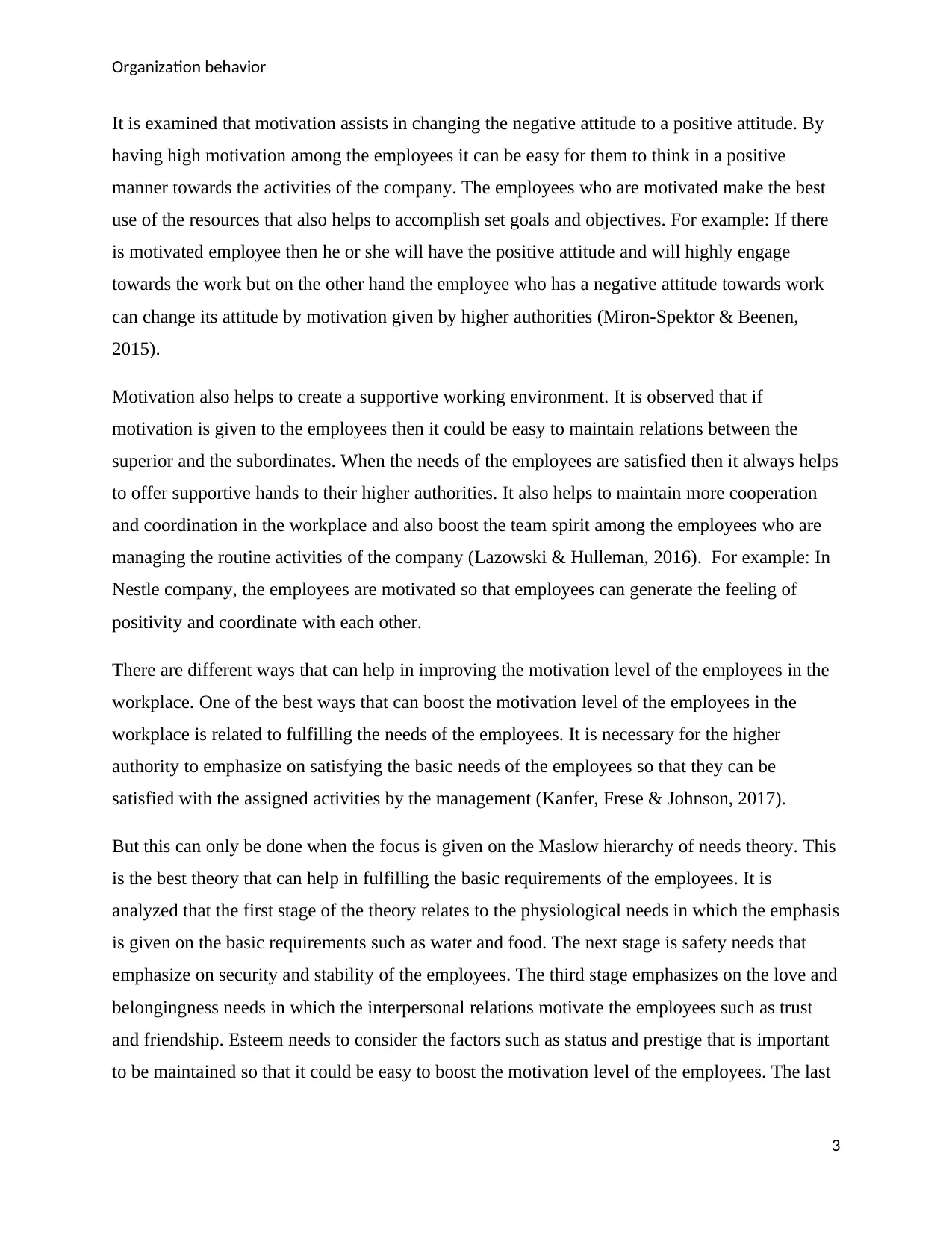
Organization behavior
It is examined that motivation assists in changing the negative attitude to a positive attitude. By
having high motivation among the employees it can be easy for them to think in a positive
manner towards the activities of the company. The employees who are motivated make the best
use of the resources that also helps to accomplish set goals and objectives. For example: If there
is motivated employee then he or she will have the positive attitude and will highly engage
towards the work but on the other hand the employee who has a negative attitude towards work
can change its attitude by motivation given by higher authorities (Miron-Spektor & Beenen,
2015).
Motivation also helps to create a supportive working environment. It is observed that if
motivation is given to the employees then it could be easy to maintain relations between the
superior and the subordinates. When the needs of the employees are satisfied then it always helps
to offer supportive hands to their higher authorities. It also helps to maintain more cooperation
and coordination in the workplace and also boost the team spirit among the employees who are
managing the routine activities of the company (Lazowski & Hulleman, 2016). For example: In
Nestle company, the employees are motivated so that employees can generate the feeling of
positivity and coordinate with each other.
There are different ways that can help in improving the motivation level of the employees in the
workplace. One of the best ways that can boost the motivation level of the employees in the
workplace is related to fulfilling the needs of the employees. It is necessary for the higher
authority to emphasize on satisfying the basic needs of the employees so that they can be
satisfied with the assigned activities by the management (Kanfer, Frese & Johnson, 2017).
But this can only be done when the focus is given on the Maslow hierarchy of needs theory. This
is the best theory that can help in fulfilling the basic requirements of the employees. It is
analyzed that the first stage of the theory relates to the physiological needs in which the emphasis
is given on the basic requirements such as water and food. The next stage is safety needs that
emphasize on security and stability of the employees. The third stage emphasizes on the love and
belongingness needs in which the interpersonal relations motivate the employees such as trust
and friendship. Esteem needs to consider the factors such as status and prestige that is important
to be maintained so that it could be easy to boost the motivation level of the employees. The last
3
It is examined that motivation assists in changing the negative attitude to a positive attitude. By
having high motivation among the employees it can be easy for them to think in a positive
manner towards the activities of the company. The employees who are motivated make the best
use of the resources that also helps to accomplish set goals and objectives. For example: If there
is motivated employee then he or she will have the positive attitude and will highly engage
towards the work but on the other hand the employee who has a negative attitude towards work
can change its attitude by motivation given by higher authorities (Miron-Spektor & Beenen,
2015).
Motivation also helps to create a supportive working environment. It is observed that if
motivation is given to the employees then it could be easy to maintain relations between the
superior and the subordinates. When the needs of the employees are satisfied then it always helps
to offer supportive hands to their higher authorities. It also helps to maintain more cooperation
and coordination in the workplace and also boost the team spirit among the employees who are
managing the routine activities of the company (Lazowski & Hulleman, 2016). For example: In
Nestle company, the employees are motivated so that employees can generate the feeling of
positivity and coordinate with each other.
There are different ways that can help in improving the motivation level of the employees in the
workplace. One of the best ways that can boost the motivation level of the employees in the
workplace is related to fulfilling the needs of the employees. It is necessary for the higher
authority to emphasize on satisfying the basic needs of the employees so that they can be
satisfied with the assigned activities by the management (Kanfer, Frese & Johnson, 2017).
But this can only be done when the focus is given on the Maslow hierarchy of needs theory. This
is the best theory that can help in fulfilling the basic requirements of the employees. It is
analyzed that the first stage of the theory relates to the physiological needs in which the emphasis
is given on the basic requirements such as water and food. The next stage is safety needs that
emphasize on security and stability of the employees. The third stage emphasizes on the love and
belongingness needs in which the interpersonal relations motivate the employees such as trust
and friendship. Esteem needs to consider the factors such as status and prestige that is important
to be maintained so that it could be easy to boost the motivation level of the employees. The last
3
⊘ This is a preview!⊘
Do you want full access?
Subscribe today to unlock all pages.

Trusted by 1+ million students worldwide
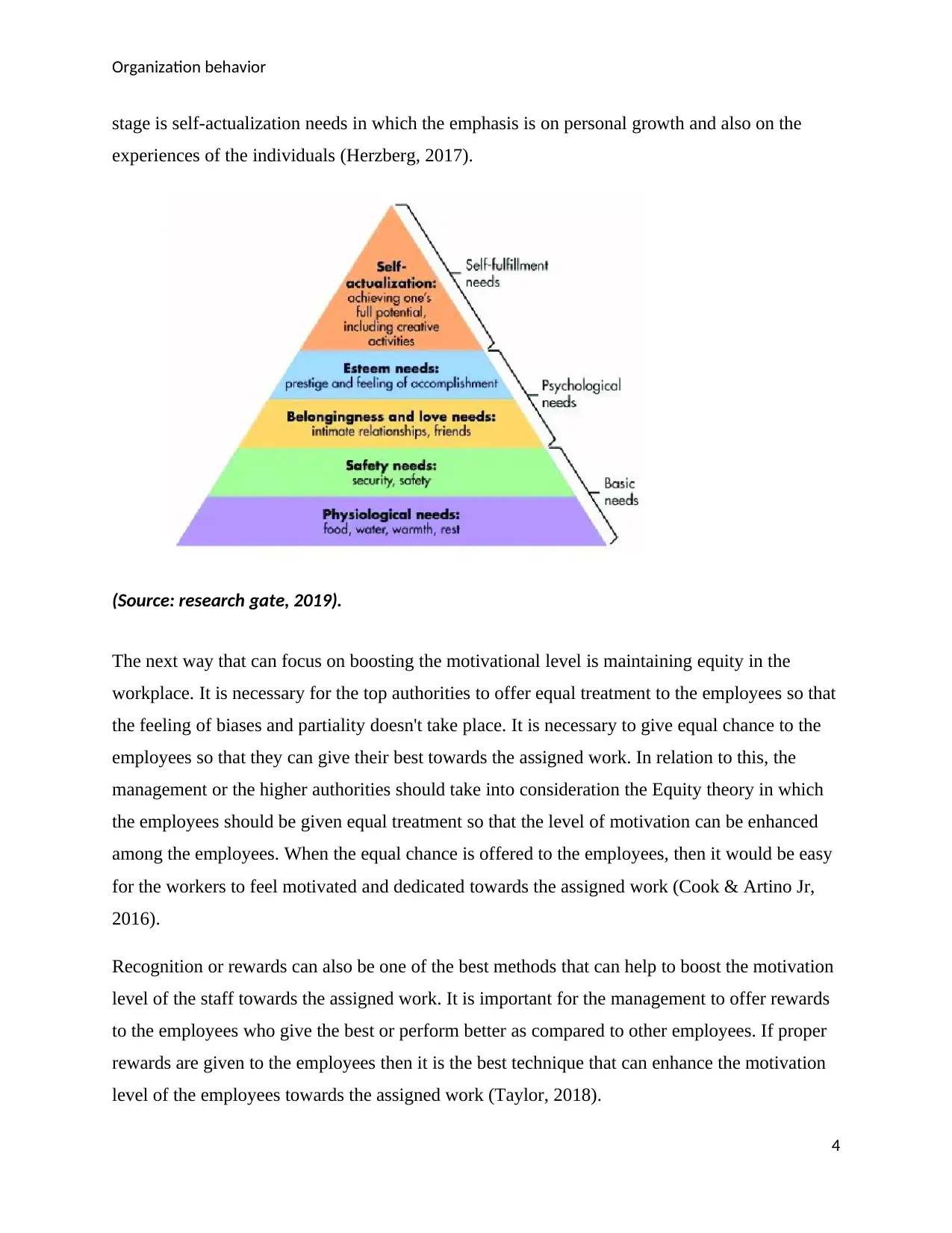
Organization behavior
stage is self-actualization needs in which the emphasis is on personal growth and also on the
experiences of the individuals (Herzberg, 2017).
(Source: research gate, 2019).
The next way that can focus on boosting the motivational level is maintaining equity in the
workplace. It is necessary for the top authorities to offer equal treatment to the employees so that
the feeling of biases and partiality doesn't take place. It is necessary to give equal chance to the
employees so that they can give their best towards the assigned work. In relation to this, the
management or the higher authorities should take into consideration the Equity theory in which
the employees should be given equal treatment so that the level of motivation can be enhanced
among the employees. When the equal chance is offered to the employees, then it would be easy
for the workers to feel motivated and dedicated towards the assigned work (Cook & Artino Jr,
2016).
Recognition or rewards can also be one of the best methods that can help to boost the motivation
level of the staff towards the assigned work. It is important for the management to offer rewards
to the employees who give the best or perform better as compared to other employees. If proper
rewards are given to the employees then it is the best technique that can enhance the motivation
level of the employees towards the assigned work (Taylor, 2018).
4
stage is self-actualization needs in which the emphasis is on personal growth and also on the
experiences of the individuals (Herzberg, 2017).
(Source: research gate, 2019).
The next way that can focus on boosting the motivational level is maintaining equity in the
workplace. It is necessary for the top authorities to offer equal treatment to the employees so that
the feeling of biases and partiality doesn't take place. It is necessary to give equal chance to the
employees so that they can give their best towards the assigned work. In relation to this, the
management or the higher authorities should take into consideration the Equity theory in which
the employees should be given equal treatment so that the level of motivation can be enhanced
among the employees. When the equal chance is offered to the employees, then it would be easy
for the workers to feel motivated and dedicated towards the assigned work (Cook & Artino Jr,
2016).
Recognition or rewards can also be one of the best methods that can help to boost the motivation
level of the staff towards the assigned work. It is important for the management to offer rewards
to the employees who give the best or perform better as compared to other employees. If proper
rewards are given to the employees then it is the best technique that can enhance the motivation
level of the employees towards the assigned work (Taylor, 2018).
4
Paraphrase This Document
Need a fresh take? Get an instant paraphrase of this document with our AI Paraphraser
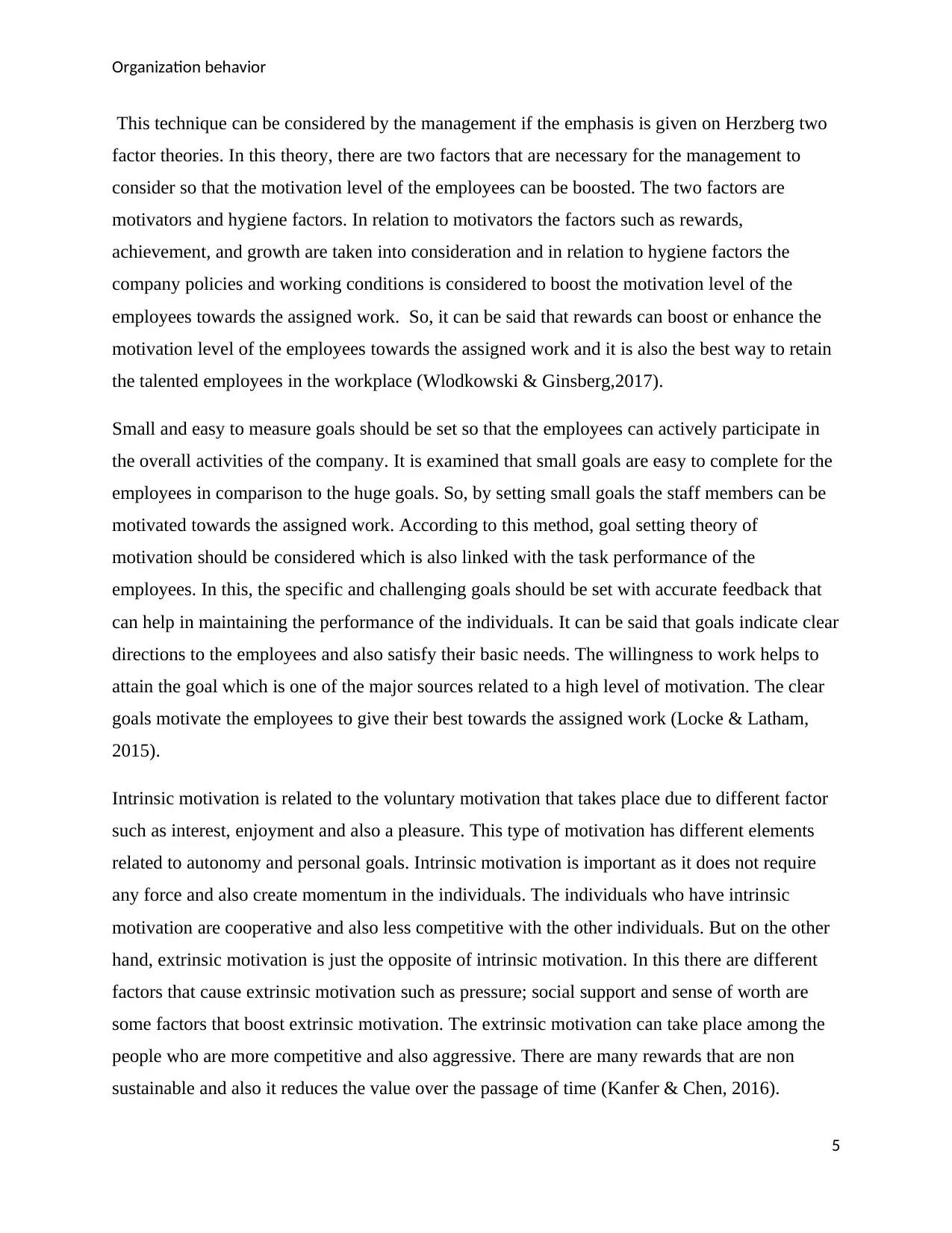
Organization behavior
This technique can be considered by the management if the emphasis is given on Herzberg two
factor theories. In this theory, there are two factors that are necessary for the management to
consider so that the motivation level of the employees can be boosted. The two factors are
motivators and hygiene factors. In relation to motivators the factors such as rewards,
achievement, and growth are taken into consideration and in relation to hygiene factors the
company policies and working conditions is considered to boost the motivation level of the
employees towards the assigned work. So, it can be said that rewards can boost or enhance the
motivation level of the employees towards the assigned work and it is also the best way to retain
the talented employees in the workplace (Wlodkowski & Ginsberg,2017).
Small and easy to measure goals should be set so that the employees can actively participate in
the overall activities of the company. It is examined that small goals are easy to complete for the
employees in comparison to the huge goals. So, by setting small goals the staff members can be
motivated towards the assigned work. According to this method, goal setting theory of
motivation should be considered which is also linked with the task performance of the
employees. In this, the specific and challenging goals should be set with accurate feedback that
can help in maintaining the performance of the individuals. It can be said that goals indicate clear
directions to the employees and also satisfy their basic needs. The willingness to work helps to
attain the goal which is one of the major sources related to a high level of motivation. The clear
goals motivate the employees to give their best towards the assigned work (Locke & Latham,
2015).
Intrinsic motivation is related to the voluntary motivation that takes place due to different factor
such as interest, enjoyment and also a pleasure. This type of motivation has different elements
related to autonomy and personal goals. Intrinsic motivation is important as it does not require
any force and also create momentum in the individuals. The individuals who have intrinsic
motivation are cooperative and also less competitive with the other individuals. But on the other
hand, extrinsic motivation is just the opposite of intrinsic motivation. In this there are different
factors that cause extrinsic motivation such as pressure; social support and sense of worth are
some factors that boost extrinsic motivation. The extrinsic motivation can take place among the
people who are more competitive and also aggressive. There are many rewards that are non
sustainable and also it reduces the value over the passage of time (Kanfer & Chen, 2016).
5
This technique can be considered by the management if the emphasis is given on Herzberg two
factor theories. In this theory, there are two factors that are necessary for the management to
consider so that the motivation level of the employees can be boosted. The two factors are
motivators and hygiene factors. In relation to motivators the factors such as rewards,
achievement, and growth are taken into consideration and in relation to hygiene factors the
company policies and working conditions is considered to boost the motivation level of the
employees towards the assigned work. So, it can be said that rewards can boost or enhance the
motivation level of the employees towards the assigned work and it is also the best way to retain
the talented employees in the workplace (Wlodkowski & Ginsberg,2017).
Small and easy to measure goals should be set so that the employees can actively participate in
the overall activities of the company. It is examined that small goals are easy to complete for the
employees in comparison to the huge goals. So, by setting small goals the staff members can be
motivated towards the assigned work. According to this method, goal setting theory of
motivation should be considered which is also linked with the task performance of the
employees. In this, the specific and challenging goals should be set with accurate feedback that
can help in maintaining the performance of the individuals. It can be said that goals indicate clear
directions to the employees and also satisfy their basic needs. The willingness to work helps to
attain the goal which is one of the major sources related to a high level of motivation. The clear
goals motivate the employees to give their best towards the assigned work (Locke & Latham,
2015).
Intrinsic motivation is related to the voluntary motivation that takes place due to different factor
such as interest, enjoyment and also a pleasure. This type of motivation has different elements
related to autonomy and personal goals. Intrinsic motivation is important as it does not require
any force and also create momentum in the individuals. The individuals who have intrinsic
motivation are cooperative and also less competitive with the other individuals. But on the other
hand, extrinsic motivation is just the opposite of intrinsic motivation. In this there are different
factors that cause extrinsic motivation such as pressure; social support and sense of worth are
some factors that boost extrinsic motivation. The extrinsic motivation can take place among the
people who are more competitive and also aggressive. There are many rewards that are non
sustainable and also it reduces the value over the passage of time (Kanfer & Chen, 2016).
5
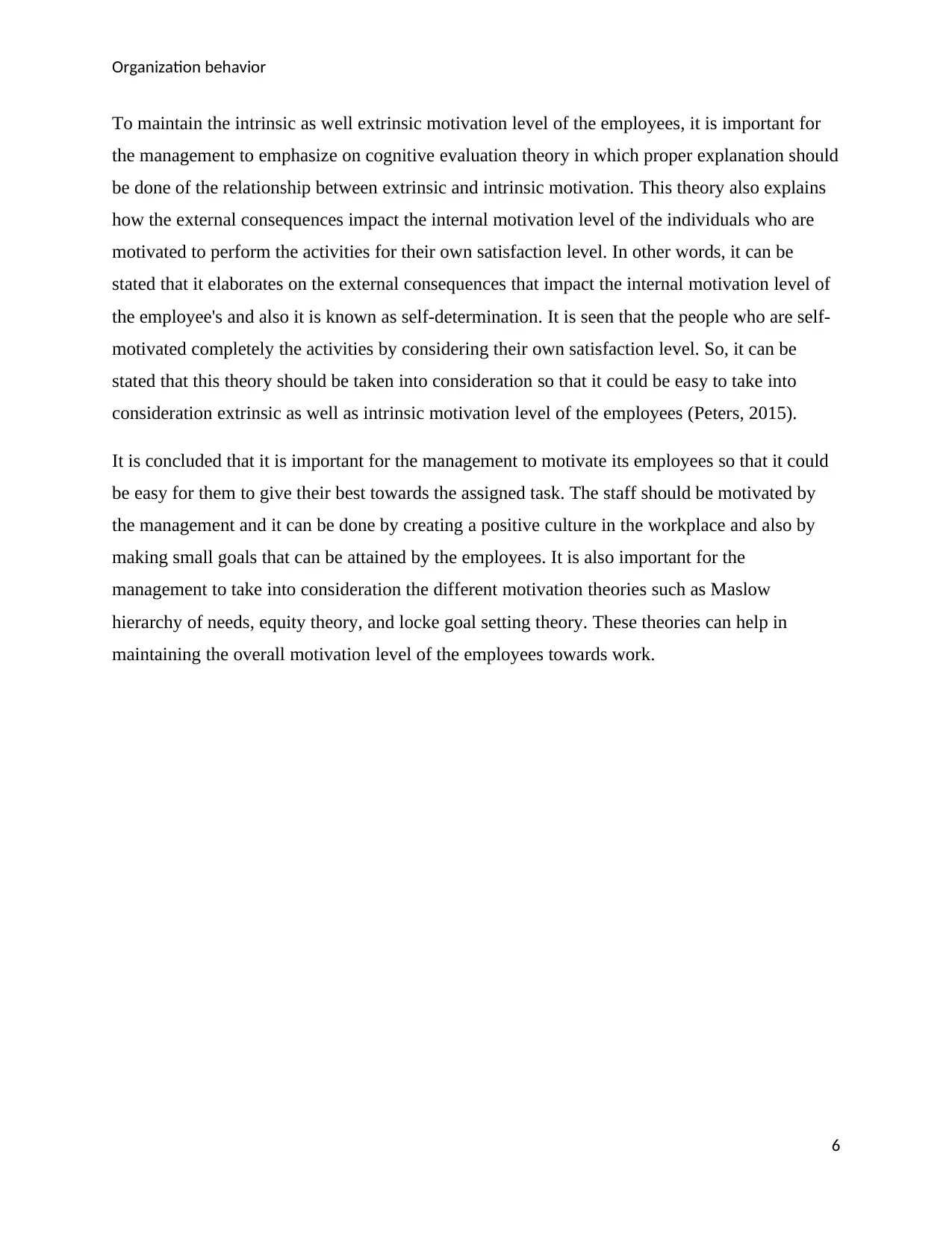
Organization behavior
To maintain the intrinsic as well extrinsic motivation level of the employees, it is important for
the management to emphasize on cognitive evaluation theory in which proper explanation should
be done of the relationship between extrinsic and intrinsic motivation. This theory also explains
how the external consequences impact the internal motivation level of the individuals who are
motivated to perform the activities for their own satisfaction level. In other words, it can be
stated that it elaborates on the external consequences that impact the internal motivation level of
the employee's and also it is known as self-determination. It is seen that the people who are self-
motivated completely the activities by considering their own satisfaction level. So, it can be
stated that this theory should be taken into consideration so that it could be easy to take into
consideration extrinsic as well as intrinsic motivation level of the employees (Peters, 2015).
It is concluded that it is important for the management to motivate its employees so that it could
be easy for them to give their best towards the assigned task. The staff should be motivated by
the management and it can be done by creating a positive culture in the workplace and also by
making small goals that can be attained by the employees. It is also important for the
management to take into consideration the different motivation theories such as Maslow
hierarchy of needs, equity theory, and locke goal setting theory. These theories can help in
maintaining the overall motivation level of the employees towards work.
6
To maintain the intrinsic as well extrinsic motivation level of the employees, it is important for
the management to emphasize on cognitive evaluation theory in which proper explanation should
be done of the relationship between extrinsic and intrinsic motivation. This theory also explains
how the external consequences impact the internal motivation level of the individuals who are
motivated to perform the activities for their own satisfaction level. In other words, it can be
stated that it elaborates on the external consequences that impact the internal motivation level of
the employee's and also it is known as self-determination. It is seen that the people who are self-
motivated completely the activities by considering their own satisfaction level. So, it can be
stated that this theory should be taken into consideration so that it could be easy to take into
consideration extrinsic as well as intrinsic motivation level of the employees (Peters, 2015).
It is concluded that it is important for the management to motivate its employees so that it could
be easy for them to give their best towards the assigned task. The staff should be motivated by
the management and it can be done by creating a positive culture in the workplace and also by
making small goals that can be attained by the employees. It is also important for the
management to take into consideration the different motivation theories such as Maslow
hierarchy of needs, equity theory, and locke goal setting theory. These theories can help in
maintaining the overall motivation level of the employees towards work.
6
⊘ This is a preview!⊘
Do you want full access?
Subscribe today to unlock all pages.

Trusted by 1+ million students worldwide
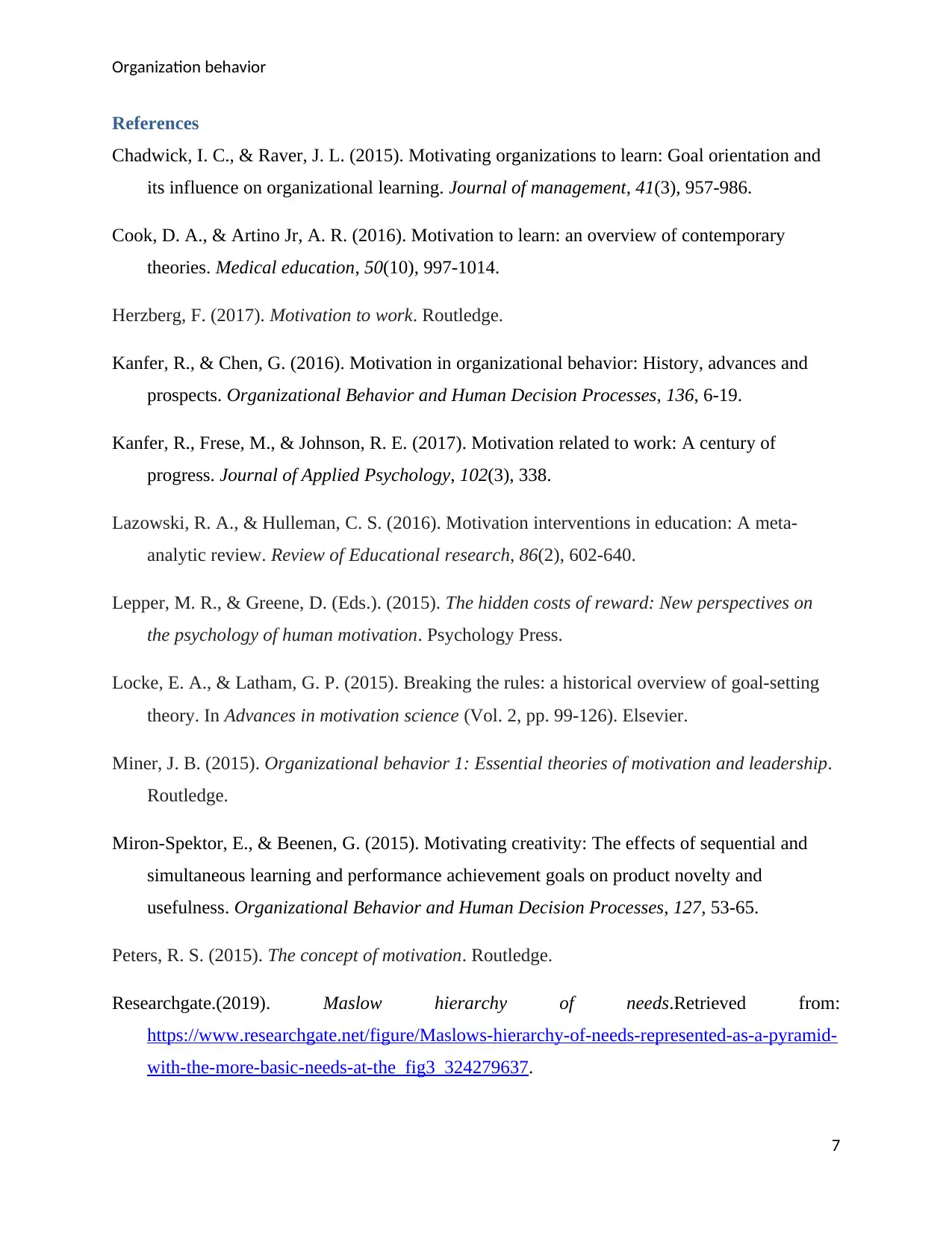
Organization behavior
References
Chadwick, I. C., & Raver, J. L. (2015). Motivating organizations to learn: Goal orientation and
its influence on organizational learning. Journal of management, 41(3), 957-986.
Cook, D. A., & Artino Jr, A. R. (2016). Motivation to learn: an overview of contemporary
theories. Medical education, 50(10), 997-1014.
Herzberg, F. (2017). Motivation to work. Routledge.
Kanfer, R., & Chen, G. (2016). Motivation in organizational behavior: History, advances and
prospects. Organizational Behavior and Human Decision Processes, 136, 6-19.
Kanfer, R., Frese, M., & Johnson, R. E. (2017). Motivation related to work: A century of
progress. Journal of Applied Psychology, 102(3), 338.
Lazowski, R. A., & Hulleman, C. S. (2016). Motivation interventions in education: A meta-
analytic review. Review of Educational research, 86(2), 602-640.
Lepper, M. R., & Greene, D. (Eds.). (2015). The hidden costs of reward: New perspectives on
the psychology of human motivation. Psychology Press.
Locke, E. A., & Latham, G. P. (2015). Breaking the rules: a historical overview of goal-setting
theory. In Advances in motivation science (Vol. 2, pp. 99-126). Elsevier.
Miner, J. B. (2015). Organizational behavior 1: Essential theories of motivation and leadership.
Routledge.
Miron-Spektor, E., & Beenen, G. (2015). Motivating creativity: The effects of sequential and
simultaneous learning and performance achievement goals on product novelty and
usefulness. Organizational Behavior and Human Decision Processes, 127, 53-65.
Peters, R. S. (2015). The concept of motivation. Routledge.
Researchgate.(2019). Maslow hierarchy of needs.Retrieved from:
https://www.researchgate.net/figure/Maslows-hierarchy-of-needs-represented-as-a-pyramid-
with-the-more-basic-needs-at-the_fig3_324279637.
7
References
Chadwick, I. C., & Raver, J. L. (2015). Motivating organizations to learn: Goal orientation and
its influence on organizational learning. Journal of management, 41(3), 957-986.
Cook, D. A., & Artino Jr, A. R. (2016). Motivation to learn: an overview of contemporary
theories. Medical education, 50(10), 997-1014.
Herzberg, F. (2017). Motivation to work. Routledge.
Kanfer, R., & Chen, G. (2016). Motivation in organizational behavior: History, advances and
prospects. Organizational Behavior and Human Decision Processes, 136, 6-19.
Kanfer, R., Frese, M., & Johnson, R. E. (2017). Motivation related to work: A century of
progress. Journal of Applied Psychology, 102(3), 338.
Lazowski, R. A., & Hulleman, C. S. (2016). Motivation interventions in education: A meta-
analytic review. Review of Educational research, 86(2), 602-640.
Lepper, M. R., & Greene, D. (Eds.). (2015). The hidden costs of reward: New perspectives on
the psychology of human motivation. Psychology Press.
Locke, E. A., & Latham, G. P. (2015). Breaking the rules: a historical overview of goal-setting
theory. In Advances in motivation science (Vol. 2, pp. 99-126). Elsevier.
Miner, J. B. (2015). Organizational behavior 1: Essential theories of motivation and leadership.
Routledge.
Miron-Spektor, E., & Beenen, G. (2015). Motivating creativity: The effects of sequential and
simultaneous learning and performance achievement goals on product novelty and
usefulness. Organizational Behavior and Human Decision Processes, 127, 53-65.
Peters, R. S. (2015). The concept of motivation. Routledge.
Researchgate.(2019). Maslow hierarchy of needs.Retrieved from:
https://www.researchgate.net/figure/Maslows-hierarchy-of-needs-represented-as-a-pyramid-
with-the-more-basic-needs-at-the_fig3_324279637.
7
Paraphrase This Document
Need a fresh take? Get an instant paraphrase of this document with our AI Paraphraser
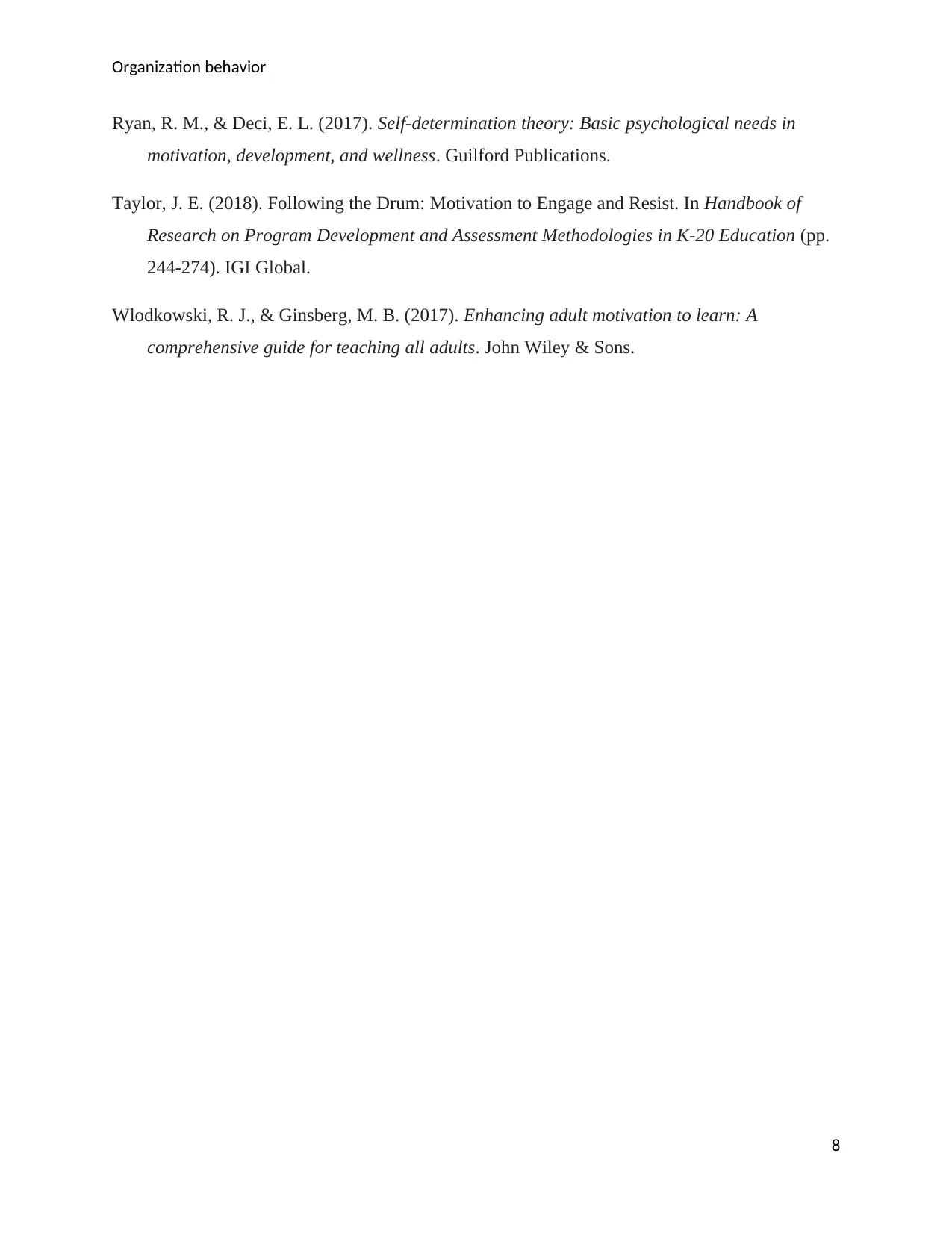
Organization behavior
Ryan, R. M., & Deci, E. L. (2017). Self-determination theory: Basic psychological needs in
motivation, development, and wellness. Guilford Publications.
Taylor, J. E. (2018). Following the Drum: Motivation to Engage and Resist. In Handbook of
Research on Program Development and Assessment Methodologies in K-20 Education (pp.
244-274). IGI Global.
Wlodkowski, R. J., & Ginsberg, M. B. (2017). Enhancing adult motivation to learn: A
comprehensive guide for teaching all adults. John Wiley & Sons.
8
Ryan, R. M., & Deci, E. L. (2017). Self-determination theory: Basic psychological needs in
motivation, development, and wellness. Guilford Publications.
Taylor, J. E. (2018). Following the Drum: Motivation to Engage and Resist. In Handbook of
Research on Program Development and Assessment Methodologies in K-20 Education (pp.
244-274). IGI Global.
Wlodkowski, R. J., & Ginsberg, M. B. (2017). Enhancing adult motivation to learn: A
comprehensive guide for teaching all adults. John Wiley & Sons.
8
1 out of 8
Related Documents
Your All-in-One AI-Powered Toolkit for Academic Success.
+13062052269
info@desklib.com
Available 24*7 on WhatsApp / Email
![[object Object]](/_next/static/media/star-bottom.7253800d.svg)
Unlock your academic potential
Copyright © 2020–2025 A2Z Services. All Rights Reserved. Developed and managed by ZUCOL.





